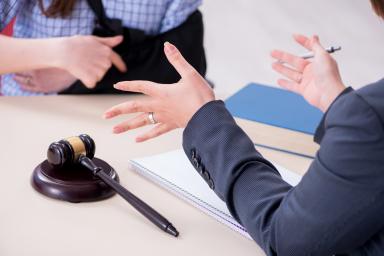New York Slip-and-Fall Laws

Slip-and-fall accidents are among the most common causes of injuries in New York State, with over 132,000 fall-related accidents being treated in hospitals each year. These accidents can happen anywhere, from icy sidewalks to poorly maintained premises, leaving victims with severe injuries and substantial medical expenses. Understanding the legal landscape surrounding slip-and-fall accidents is crucial for anyone who has experienced such an accident.
This article delves into New York State's slip-and-fall, exploring the duty of care property owners owe to visitors, the concept of negligence, and the importance of providing notice. Knowledge of these laws can empower individuals to protect their rights and seek fair compensation when confronted with the aftermath of a slip-and-fall accident in New York State.
Duty of Care
In New York State, a duty of care refers to the legal obligation that property owners and occupiers have to maintain their premises reasonably safe for visitors, guests, and customers. This duty extends to anyone legally allowed to be on the property, whether invited, licensed, or even trespassed in some cases.
For example, property owners owe the highest duty of care to invitees. They must take proactive measures to keep their premises safe, including regularly inspecting for hazards and promptly addressing any dangers. On the other hand, property owners generally do not owe a duty of care to trespassers, but they cannot intentionally cause harm or set traps to injure them. Moreover, if the property owner is aware of frequent trespassers, such as children playing in the yard, there still may be some duty to warn or protect them if a slip-and-fall injury is possible.
Negligence
Regarding slip-and-fall laws, negligence and duty of care are closely related. Negligence is the legal concept of establishing liability in a personal injury claim, specifically in slip-and-fall accidents. Negligence occurs when someone fails to uphold their duty of care, resulting in harm to another person, otherwise known as a breach of duty.
A property owner’s breach of duty can occur in several ways, such as:
Failing to repair or maintain a known hazardous condition, like a broken staircase or slippery surface
Neglecting to warn visitors of potential dangers, such as wet floors or uneven surfaces
Ignoring local building codes or safety regulations that could prevent accidents
Comparative Negligence
Comparative negligence is a legal principle used to determine the degree of fault of each party involved in an accident or injury, including slip-and-fall accidents, in New York State. It is a method of apportioning responsibility for an accident based on the actions or negligence of all parties involved. Under comparative negligence, the amount of compensation an injured person can recover is reduced proportionally to their degree of fault.
New York follows the doctrine of pure comparative negligence, which means that even if an injured person is partially at fault for their slip-and-fall accident, they can still seek compensation for their injuries. However, the amount of compensation they receive will be reduced based on their percentage of fault.
If the court finds that both the plaintiff and the defendant were negligent and contributed to the accident, they will assign a percentage of fault to each party. For example, the court might determine that the plaintiff was 30% at fault and the property owner was 70% at fault. The total compensation the plaintiff is eligible to receive will be reduced by their percentage of fault. If the total damages are $10,000, the plaintiff will be entitled to receive $7,000 (70% of $10,000) after accounting for their 30% share of fault.
Notice
In some cases, the property owner or occupier may not be held liable if they were unaware of the dangerous condition and had no reasonable opportunity to correct it. There are two main types of notice that can be relevant in slip-and-fall cases:
Actual Notice: Actual notice means that the property owner or occupier was aware of the dangerous condition on their premises before the slip-and-fall accident occurred. For example, if a store owner knew about a leaking roof that caused a slippery floor but failed to fix it or display warning signs, they had actual notice of the hazardous condition.
Constructive Notice: Constructive notice refers to a situation where the property owner or occupier should have known about the dangerous condition because it existed for a sufficient amount of time that a reasonable person would have discovered and addressed it. In other words, the hazardous condition was present for an extended period, and the property owner should have realized it and taken corrective action to exercise reasonable care.
Providing notice is essential in slip-and-fall cases because it helps determine whether the property owner was negligent in maintaining their premises. If the property owner had actual or constructive notice of the hazardous condition and failed to address it or provide warnings, they may be held liable for the slip-and-fall accident.
New York Business Liability Insurance Requirements
New York State does not require businesses to hold liability insurance by law. However, they are generally advised to carry general liability insurance. This helps protect them from financial losses due to bodily injury and property damage claims, including slip-and-fall accidents.
Business liability insurance typically covers legal expenses, medical costs, and settlements or judgments resulting from slip-and-fall accidents on business premises. The coverage amount may vary based on the size and type of business and the policy they hold.
How Much Can Someone Sue for a Slip-and-Fall in New York?
There is no specific cap or limit on compensatory damages that can be awarded for slip-and-fall cases in New York. The amount someone can sue depends on the case's specific circumstances and the extent of the injuries and damages suffered.
Compensatory damages in slip-and-fall cases may include medical expenses, lost wages, pain and suffering, and emotional distress. The total amount of compensation awarded will be based on the evidence presented, the injuries' severity, and the accident's impact on the individual's life.
The Statute of Limitations in New York
In New York State, the statute of limitations for filing a personal injury lawsuit, including slip-and-fall accidents, is generally three years from the accident date. Therefore, injured individuals have three years from the slip-and-fall accident date to initiate legal proceedings and seek damages.
If the lawsuit is not filed within three years, the injured person may lose their right to pursue compensation through the court system. It's essential to consult with a personal injury attorney promptly to understand your case's specific deadline and ensure timely filing within the statute of limitations.
Resources for Injured Folks in New York
If you've been injured in a slip-and-fall accident in New York, it's essential to know your rights and the available legal resources that can help you seek fair compensation. These resources can help you better understand your options and support you in protecting your interests and pursue the compensation you deserve.
New York State Courts
The official website of the New York State Unified Court System provides valuable resources for individuals injured in slip-and-fall accidents. It offers information on court locations, procedures, and access to legal forms. Additionally, the website guides self-represented litigants, helping those who wish to pursue their cases without an attorney. The website can be used to research relevant laws, rules, and court decisions related to slip-and-fall accidents in New York State.
Legal Aid Society of New York
The Legal Aid Society of New York is a prominent legal aid organization offering free legal assistance to low-income individuals in New York City. While they handle various civil legal matters, including personal injury cases, individuals injured by slip-and-fall accidents may seek their help. They provide experienced attorneys who can guide injured parties through the legal process, investigate the accident, and advocate for fair compensation. Eligible people can access their services to protect their rights and pursue a personal injury claim without financial burden.
Legal Assistance of Western New York
This organization offers free legal services to low-income individuals in 14 counties in western New York, including personal injury cases like slip-and-fall accidents. Eligible individuals can access their experienced attorneys, who will help navigate the legal process, investigate the accident, and pursue fair compensation for injuries and damages. Their services are designed to support those who may not otherwise be able to afford legal representation, ensuring injured parties have access to legal resources and protection of their rights.
Empire Justice Center
Empire Justice Center is a vital legal resource for New Yorkers injured in slip-and-fall accidents. As a statewide legal aid organization focused on social justice, they provide free legal assistance to low-income individuals. Their practiced lawyers can guide injured parties through the complexities of a slip-and-fall case, advocate for their rights, and pursue fair compensation. Eligible New Yorkers can access their services to level the playing field against powerful entities, ensuring that justice is attainable regardless of financial means. Empire Justice Center's commitment to fighting poverty and promoting social equity makes them a trusted ally for those seeking legal help after a slip-and-fall accident in New York.
Expertise.com StaffAuthor
Step into the world of Expertise.com, your go-to hub for credible insights. We don't take accuracy lightly around here. Our squad of expert reviewers, each a maestro in their field, has given the green light to every single article you'll find. From rigorous fact-checking to meticulous evaluations of service providers, we've got it all covered. So feel free to dive in and explore. The information you'll uncover has been stamped with the seal of approval by our top-notch experts.

![How Much Does a Slip-and-Fall Lawyer Cost? [2023] DUP IMAGE](https://images.ctfassets.net/k00sbju4hbzq/6VjmgolPspyVjYLOfVY4wl/a1f9b84358d5e0069656c41ac3e63e96/Depositphotos_260604210_XL.jpg?fit=fill&w=384&q=75)


